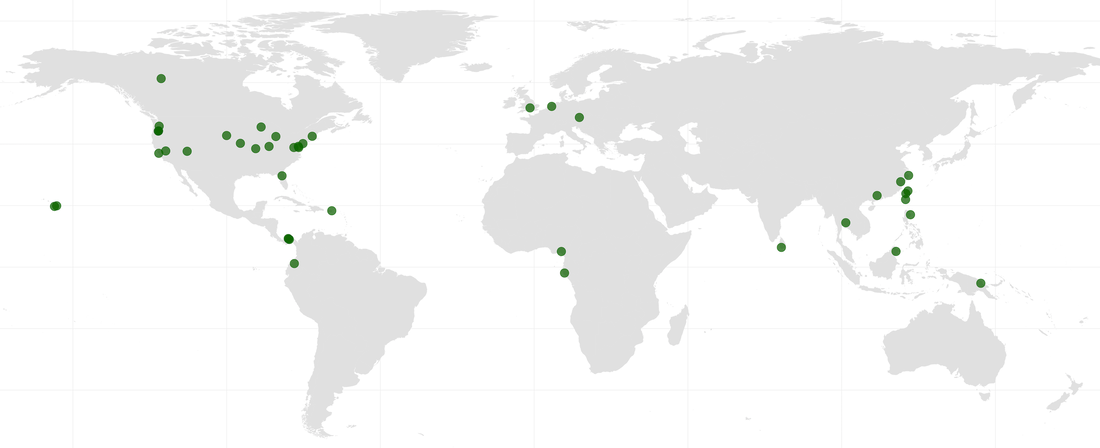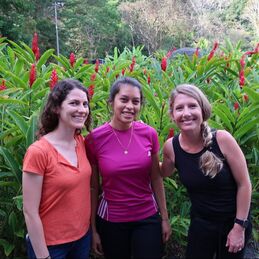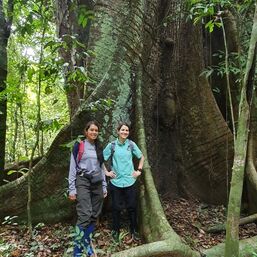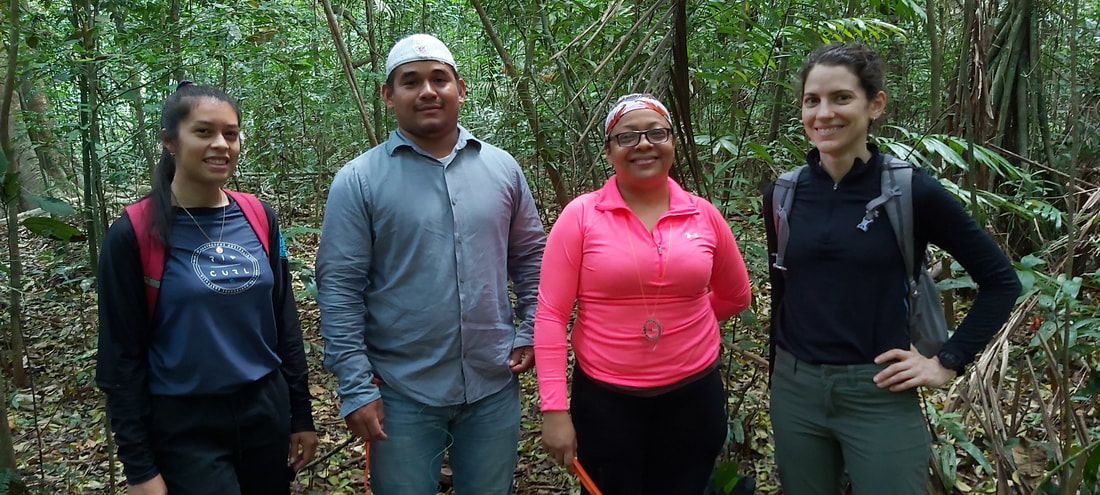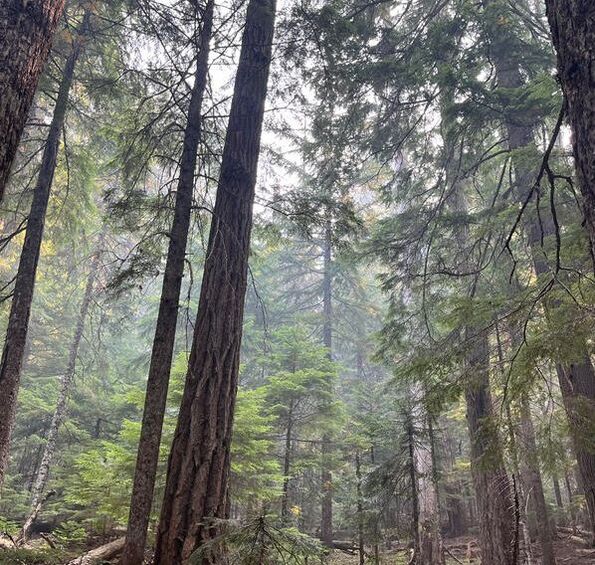Project Overview
Soil microbial communities play a pivotal role in the maintenance of plant community diversity and structure. Two important groups of microbes that contribute to structuring plant communities are pathogens and mutualists. Soil-borne pathogens maintain community level plant diversity, as accumulation of species-specific pathogens around a tree suppresses recruitment of that species’ offspring. This ‘conspecific negative density dependence’ (CNDD), prevents any one species from dominating and allows a diversity of species to establish. However, trees also accumulate plant mutualists, or beneficial microbes, particularly mycorrhizal fungi. Although historically, CNDD is explained through negative pathogen effects, mycorrhizal fungi may influence the net outcome, as species-specific, or high specificity, interactions with these mutualists could drive improved recruitment near the parent tree, counteracting pathogen-driven reduced recruitment. Further, the strength of the tradeoff between mutualist and pathogen effects on CNDD may be mediated by both the specificity of the mutualist and environmental limitations on microbial distribution. Different types of mycorrhizal fungi should differ systematically in their ability to weaken pathogen-driven CNDD, with a positive recruitment effect stronger in trees associating with higher specificity mutualists.
In this ambitious project, we will test for the relative contribution of mutualists and pathogens, as well mycorrhizal specificity, to CNDD. We will also study the impact of environmental variables on the distribution of these major plant-associated soil microbial groups worldwide, linking this distribution to global forest diversity. In collaboration with plot PIs, we are leveraging the ForestGEO network established by the Smithsonian Tropical Research Institute (STRI) to link the composition of the plant microbiome at a local scale to processes occurring at the scale of an entire forest and across the globe.
Soil microbial communities play a pivotal role in the maintenance of plant community diversity and structure. Two important groups of microbes that contribute to structuring plant communities are pathogens and mutualists. Soil-borne pathogens maintain community level plant diversity, as accumulation of species-specific pathogens around a tree suppresses recruitment of that species’ offspring. This ‘conspecific negative density dependence’ (CNDD), prevents any one species from dominating and allows a diversity of species to establish. However, trees also accumulate plant mutualists, or beneficial microbes, particularly mycorrhizal fungi. Although historically, CNDD is explained through negative pathogen effects, mycorrhizal fungi may influence the net outcome, as species-specific, or high specificity, interactions with these mutualists could drive improved recruitment near the parent tree, counteracting pathogen-driven reduced recruitment. Further, the strength of the tradeoff between mutualist and pathogen effects on CNDD may be mediated by both the specificity of the mutualist and environmental limitations on microbial distribution. Different types of mycorrhizal fungi should differ systematically in their ability to weaken pathogen-driven CNDD, with a positive recruitment effect stronger in trees associating with higher specificity mutualists.
In this ambitious project, we will test for the relative contribution of mutualists and pathogens, as well mycorrhizal specificity, to CNDD. We will also study the impact of environmental variables on the distribution of these major plant-associated soil microbial groups worldwide, linking this distribution to global forest diversity. In collaboration with plot PIs, we are leveraging the ForestGEO network established by the Smithsonian Tropical Research Institute (STRI) to link the composition of the plant microbiome at a local scale to processes occurring at the scale of an entire forest and across the globe.
|
I was able to visit Barro Colorado Island, a ForestGEO site and work with Dr. Erin Spear at the Smithsonian Tropical Research Institute(STRI)), our amazing research assistant Omayra Meléndez, and the census crew to sample for our project! Check out our blogs on the STRI website!
Photo credits: Dr. Erin Spear & Omayra Meléndez |
Linking Mycorrhizae and Pathogens to Conspecific Density Dependence Across an Elevational Gradient
Tree-associated fungi, encompassing both mycorrhizal mutualists and pathogenic antagonists, have emerged as important drivers of tree demography and forest composition. However, the role of fungal communities in mediating elevational and latitudinal gradients of tree diversity remains understudied. Fungal communities may shape tree diversity by influencing key biotic processes, such as conspecific density dependence (CDD). Here, we are working on connecting fungal communities, including both mycorrhizae and pathogens, to the key drivers of tree diversity across a 1000-meter elevation gradient at the H.J. Andrews Experimental Forest LTER in Oregon, USA.
Tree-associated fungi, encompassing both mycorrhizal mutualists and pathogenic antagonists, have emerged as important drivers of tree demography and forest composition. However, the role of fungal communities in mediating elevational and latitudinal gradients of tree diversity remains understudied. Fungal communities may shape tree diversity by influencing key biotic processes, such as conspecific density dependence (CDD). Here, we are working on connecting fungal communities, including both mycorrhizae and pathogens, to the key drivers of tree diversity across a 1000-meter elevation gradient at the H.J. Andrews Experimental Forest LTER in Oregon, USA.
Capacity Building
We look forward to building local capacity in using microbiome metabarcoding data. To this end, we are planning to share basic analyses for the microbiome data generated from ForestGEO plots using open access tools. We hope this will allow all collaborators to fully benefit from the resulting metabarcoding data to answer many more questions relevant to each individual plot.
We look forward to building local capacity in using microbiome metabarcoding data. To this end, we are planning to share basic analyses for the microbiome data generated from ForestGEO plots using open access tools. We hope this will allow all collaborators to fully benefit from the resulting metabarcoding data to answer many more questions relevant to each individual plot.
